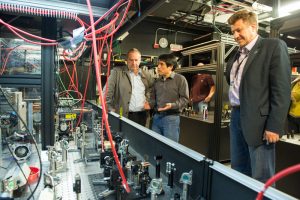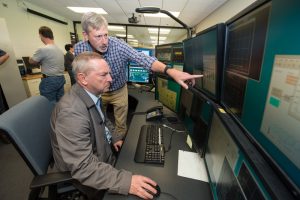
Fermilab accelerator scientist Jinhao Ruan (center) shows Fermilab Director Nigel Lockyer (left) the laser setup for the FAST photoinjector. Vladimir Shiltsev (right) is director of the Fermilab Accelerator Physics Center. Photo: Reidar Hahn
On May 16, Fermilab sent an electron beam with an energy of 50 million electronvolts, or MeV, through the photoinjector at the Fermilab Accelerator Science and Technology facility (FAST), achieving a major design goal for the accelerator – and marking the beginning of a new accelerator science program at the laboratory.
“This is a major milestone for our general accelerator R&D,” said Vladimir Shiltsev, head of the Fermilab Accelerator Physics Center. “The delivery of this beam marks the start of a new program here – new facility, new science capabilities.”
The delivery of 50-MeV beam is the first step in establishing an accelerator R&D facility that will serve as one of America’s leading test beds for cutting-edge, record-high-intensity particle beam research. Once complete, FAST will provide scientists and engineers from around the world with a place to study the science of high-intensity particle beams and superconducting radio-frequency acceleration, the technology on which nearly all future high-energy accelerators are based.
The photoinjector is just the first phase of a larger accelerator to be built at FAST, which is supported by the DOE Office of Science. It will include a superconducting linear accelerator and a particle storage ring called the Integrable Optics Test Accelerator, or IOTA, which will be built over the next two years.
Although the photoinjector is just the front section of what will become a higher-energy accelerator, it still provides enough beam to be useful for carrying out scientific research. In fact, the first accelerator physics researchers to sign up for time at the facility have now begun using the electron beam. The inaugural group, led by Northern Illinois University professors Philippe Piot and Swapan Chattopadhyay, has reserved two months of beam time as part of the Fermilab-NIU Research Cluster.

In the FAST control room and under the guidance of Fermilab scientist Elvin Harms (standing), Fermilab Director Nigel Lockyer turns on the upgraded superconducting radio-frequency cavity, called CC1. Photo: Reidar Hahn
For FAST to produce the kinds of beams that are useful for accelerator R&D, its initial electron beam had to have an energy of 50 MeV. In 2015, Fermilab delivered a 20-MeV electron beam. Since then, scientists, engineers and technicians have upgraded the photoinjector to meet specifications, including installing a refurbished accelerating cavity that had been used elsewhere on the Fermilab site.
“It takes a significant effort to install all the complex components and subsystems that make up such an accelerator, and everything has to be done just right,” said Jerry Leibfritz, project engineer for FAST. “The fact that both 20-MeV and 50-MeV beams were achieved within a day or two of the start of commissioning is truly a testament to the excellent work and dedication of all those involved in this project.”
In the current setup, electron bunches generated by a laser are accelerated through two superconducting accelerating cavities (including the refurbished cavity), which bring the energy of electrons to 50 MeV.
As work on FAST progresses, the electron beam will continue through another eight superconducting radio-frequency cavities, accelerating to 300 MeV before entering the beamline for IOTA.
“FAST represents the beginning of a new era at Fermilab, in which the study and development of high-intensity particle beams become an important and productive part of the laboratory program,” said Fermilab Director Nigel Lockyer.



